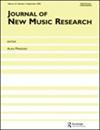音乐合奏中的协同调节时间:贝叶斯听众视角
IF 1.1
4区 计算机科学
Q4 COMPUTER SCIENCE, INTERDISCIPLINARY APPLICATIONS
引用次数: 2
摘要
合奏中的协同调节时间取决于人类及时协调行动的能力。在这里,我们探讨了一个假设,即人类预测协调行动的时间恒定性,因为他们自己的行动与他人的行动时间一致。提出了一种算法(BListener),该算法使用关于来自音乐合奏的传入时序数据的贝叶斯推断来预测时序恒定性。然后,将该算法应用于真实数据的时序分析,首先应用于由四名歌手组成的合唱团,然后应用于包含二重唱歌手表演的数据集。时间恒定性的全局特征,如波动和稳定性,与人类对音乐合奏质量的主观估计和相关的经验代理相关。在未来的工作中,BListener可以作为一个人工音乐家的组成部分,在音乐合奏中与人类音乐家一起演奏。本文章由计算机程序翻译,如有差异,请以英文原文为准。
Co-regulated timing in music ensembles: A Bayesian listener perspective
Co-regulated timing in a music ensemble rests on the human capacity to coordinate actions in time. Here we explore the hypothesis that humans predict timing constancy in coordinated actions, in view of timing their own actions in line with the others. An algorithm (BListener) is presented that predicts timing constancy, using Bayesian inference about incoming timing data from the music ensemble. The algorithm is then applied to a timing analysis of real data, first, to a choir consisting of four singers, then, to a dataset containing performances of duet singers. Global features of timing constancy, such as fluctuation and stability, correlate with human subjective estimates of the music ensembles’ quality and associated experienced agency. In future work, BListener could serve as component in an artificial musician that plays along with human musicians in a music ensemble.
求助全文
通过发布文献求助,成功后即可免费获取论文全文。
去求助
来源期刊

Journal of New Music Research
工程技术-计算机:跨学科应用
CiteScore
3.20
自引率
0.00%
发文量
5
审稿时长
>12 weeks
期刊介绍:
The Journal of New Music Research (JNMR) publishes material which increases our understanding of music and musical processes by systematic, scientific and technological means. Research published in the journal is innovative, empirically grounded and often, but not exclusively, uses quantitative methods. Articles are both musically relevant and scientifically rigorous, giving full technical details. No bounds are placed on the music or musical behaviours at issue: popular music, music of diverse cultures and the canon of western classical music are all within the Journal’s scope. Articles deal with theory, analysis, composition, performance, uses of music, instruments and other music technologies. The Journal was founded in 1972 with the original title Interface to reflect its interdisciplinary nature, drawing on musicology (including music theory), computer science, psychology, acoustics, philosophy, and other disciplines.
 求助内容:
求助内容: 应助结果提醒方式:
应助结果提醒方式:


